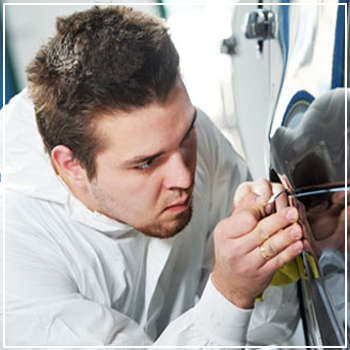 You recently discovered a dent on your car door – whether it happened in a parking lot, in your neighborhood or a from driving error, a dented car door shouldn’t be ignored. You may tell yourself it’s minor and can only be seen from certain angles, but even minor dents eventually lead to rust and corrosion. Also, if you plan to sell the vehicle down the road, that blemish devalues it.
You recently discovered a dent on your car door – whether it happened in a parking lot, in your neighborhood or a from driving error, a dented car door shouldn’t be ignored. You may tell yourself it’s minor and can only be seen from certain angles, but even minor dents eventually lead to rust and corrosion. Also, if you plan to sell the vehicle down the road, that blemish devalues it.
Dents may also affect how certain parts of your car work. If your door is out of shape, it won’t move as well or may no longer fit in the frame. As a result, you’ll be forcing their use every time you get in and out of the vehicle, which places even further stress on the internal hinges.
Although DIY techniques exist, working with the professionals at DaSilva’s Auto Body produces more reliable results. At this point, what should you know before you head over to the mechanic shop?
How Dents Get Evaluated
Is the dent small or large? Was the paint affected? How deep does it go? Before repairs begin, a technician will examine the dent for:
- Diameter
- Depth
- Stretch and scarring within the damaged area
- Location
- Cause
- Access to the dent from the back
- Car’s make and model
- Body panel material
- Paint color and age
- Outside temperature
For Small Dents
Small dents that don’t affect the car’s paint can be resolved with paintless dent repair. This process involves a series of tools to massage and push the dent out from behind. The spot of the blemish returns to its original shape, so that area does not require a new coat of paint. For your benefit, the dent is barely undetectable, the paint job matches and the process takes far less time than traditional repairs.
What may count as a “small” dent?
- Another car door hits your side door
- Shopping car hits the side of your car at a relatively low speed
- Light impacts
Visually, these dents are shallow and round in shape, but at certain angles or in a reflection, they’re fairly visible. Depending on what’s needed and where you go for repairs, costs may range between $50 and $500. Price increases with size and also varies with the location of the dent and the car’s make and model.
Larger Dents
Larger, more complex dents and ones that scratch the paint require a lengthier process. These types of dents often include:
- Dents around body lines
- Anything deeper, sharper or larger in diameter
- Bulging or noticeable high areas
- Anything resulting from a minor fender-bender
- Vandalism
- Major hailstorms
- Garage door closing on your vehicle
- Car reversing into your side door
In these cases, a technician works from the outside of the panel to destress the metal, then goes from behind with a series of rods or levers to lift the damage. More tools and a higher level of skill are needed, thus the process takes considerably longer. The paint is taken off, a filler is added and a new coat is applied. Overall, while the dent is removed and your car is back in working order, there’s always a chance that the new paint job won’t quite match your old one.
Whether your car simply needs paintless dent repair or a more complex combination of auto body repair painting, turn to DaSilva’s for timely and affordable work. To learn more about our services or to set up an appointment, give us a call today.




